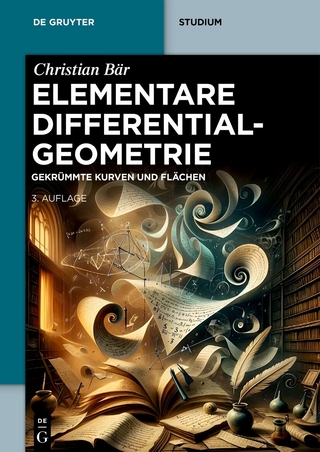Projective Geometry
Springer-Verlag New York Inc.
978-0-387-40623-7 (ISBN)
In Euclidean geometry, constructions are made with ruler and compass. Projective geometry is simpler: its constructions require only a ruler. In projective geometry one never measures anything, instead, one relates one set of points to another by a projectivity. The first two chapters of this book introduce the important concepts of the subject and provide the logical foundations. The third and fourth chapters introduce the famous theorems of Desargues and Pappus. Chapters 5 and 6 make use of projectivities on a line and plane, repectively. The next three chapters develop a self-contained account of von Staudt's approach to the theory of conics. The modern approach used in that development is exploited in Chapter 10, which deals with the simplest finite geometry that is rich enough to illustrate all the theorems nontrivially. The concluding chapters show the connections among projective, Euclidean, and analytic geometry.
1 Introduction.- 1.1 What is projective geometry?.- 1.2 Historical remarks.- 1.3 Definitions.- 1.4 The simplest geometric objects.- 1.5 Projectivities.- 1.6 Perspectivities.- 2 Triangles and Quadrangles.- 2.1 Axioms.- 2.2 Simple consequences of the axioms.- 2.3 Perspective triangles.- 2.4 Quadrangular sets.- 2.5 Harmonic sets.- 3 The Principle of Duality.- 3.1 The axiomatic basis of the principle of duality.- 3.2 The Desargues configuration.- 3.3 The invariance of the harmonic relation.- 3.4 Trilinear polarity.- 3.5 Harmonic nets.- 4 The Fundamental Theorem and Pappus’s Theorem.- 4.1 How three pairs determine a projectivity.- 4.2 Some special projectivities.- 4.3 The axis of a projectivity.- 4.4 Pappus and Desargues.- 5 One-dimensional Projectivities.- 5.1 Superposed ranges.- 5.2 Parabolic projectivities.- 5.3 Involutions.- 5.4 Hyperbolic involutions.- 6 Two-dimensional Projectivities.- 6.1 Projective collineations.- 6.2 Perspective collineations.- 6.3 Involutory collineations.- 6.4 Projective correlations.- 7 Polarities.- 7.1 Conjugate points and conjugate lines.- 7.2 The use of a self-polar triangle.- 7.3 Polar triangles.- 7.4 A construction for the polar of a point.- 7.5 The use of a self-polar pentagon.- 7.6 A self-conjugate quadrilateral.- 7.7 The product of two polarities.- 7.8 The self-polarity of the Desargues configuration.- 8 The Conic.- 8.1 How a hyperbolic polarity determines a conic.- 8.2 The polarity induced by a conic.- 8.3 Projectively related pencils.- 8.4 Conics touching two lines at given points.- 8.5 Steiner’s definition for a conic.- 9 The Conic, Continued.- 9.1 The conic touching five given lines.- 9.2 The conic through five given points.- 9.3 Conics through four given points.- 9.4 Two self-polar triangles.- 9.5 Degenerate conies.- 10 A Finite Projective Plane.- 10.1 The idea of a finite geometry.- 10.2 A combinatorial scheme for PG(2, 5).- 10.3 Verifying the axioms.- 10.4 Involutions.- 10.5 Collineations and correlations.- 10.6 Conies.- 11 Parallelism.- 11.1 Is the circle a conic?.- 11.2 Affine space.- 11.3 How two coplanar lines determine a flat pencil and a bundle.- 11.4 How two planes determine an axial pencil.- 11.5 The language of pencils and bundles.- 11.6 The plane at infinity.- 11.7 Euclidean space.- 12 Coordinates.- 12.1 The idea of analytic geometry.- 12.2 Definitions.- 12.3 Verifying the axioms for the projective plane.- 12.4 Projective collineations.- 12.5 Polarities.- 12.6 Conics.- 12.7 The analytic geometry of PG(2, 5).- 12.8 Cartesian coordinates.- 12.9 Planes of characteristic two.- Answers to Exercises.- References.
| Zusatzinfo | XII, 162 p. |
|---|---|
| Verlagsort | New York, NY |
| Sprache | englisch |
| Maße | 155 x 235 mm |
| Themenwelt | Mathematik / Informatik ► Mathematik ► Geometrie / Topologie |
| ISBN-10 | 0-387-40623-9 / 0387406239 |
| ISBN-13 | 978-0-387-40623-7 / 9780387406237 |
| Zustand | Neuware |
| Haben Sie eine Frage zum Produkt? |
aus dem Bereich




